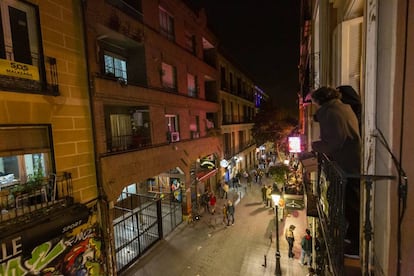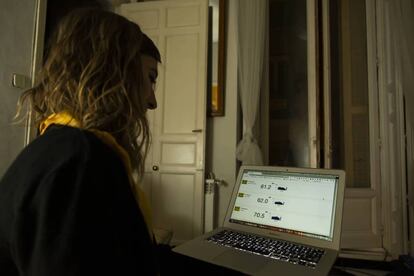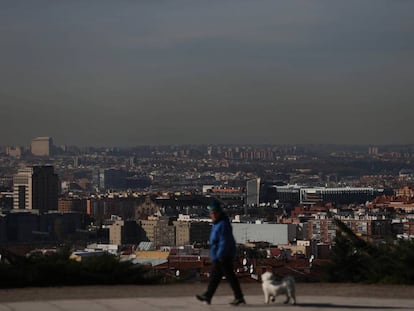For residents of Madrid’s city center, trendiness is offset by industrial levels of noise
Some homeowners in the Malasaña neighborhood have sound meters showing alarming exposure to decibels, due mostly to the vibrant nightlife. Now they are campaigning to make their homes more livable

Jimena Toscano and Andrés Martínez live in an old, unpretentious apartment in downtown Madrid where the most salient features are a red telephone in the living room, and a mural of Elvis’s face that Andrés painted on one of the walls.
By day, it is a pleasure to walk in the streets of this neighborhood, Malasaña, which still has the feel of a village. But when the sun goes down, the nightmare begins.
While noise levels in most of the Spanish capital drop beneath 55 decibels, the exposure considered optimal for rest, the opposite happens on Velarde street, which is home to several popular bars – and also where the couple’s apartment happens to be located.
A sound meter on one of their balconies shows that for five hours each night, the average noise level never drops below 70 decibels, a figure that is more readily associated with industrial areas than residential streets.
And then there are the peaks. On one recent night at 11.34pm, when the garbage truck came by, the meter showed 93 decibels. At 1.40am it hovered around 75 decibels for several minutes, the time it took a young man to play a guitar song under their balcony. At 3.22am the meter soared to 82 decibels when a young woman screamed out on the street.
The case of Velarde street makes my hair stand on end. It’s a kind of torture that I wouldn’t wish on anyone
Salvador Domingo, Blue Noise
“It’s always the same. They holler as though people were being cut to pieces,” says Jimena, a 37-year-old social worker, looking down on the street from the first-floor apartment. “Why do they need to do that?”
The fluctuating noise levels can be followed live through a link provided by a Valencia-based sound consulting company named Blue Noise, which donated three professional sound meters to residents of Malasaña last November – including this couple.
The screen is updated every five seconds to display the average of the noise levels recorded during that short period of time. Later, these figures are collected in a table showing a detailed analysis of their hourly suffering. The measurements have put numbers on an “invisible” nuisance, making it easier to file complaints. The neighborhood’s digital daily, Somos Malasaña, has run an article on the subject.

On Velarde street, noise levels only fall below 55 decibels at 7am. Inside Andrés and Jimena’s old apartment, which has been fitted with double-glazed windows, one hears the constant chatter of dozens of youths down at street level, where there are five bars in close proximity: the Vía Láctea – a famous bar that opened in 1979 and became a symbol of the so-called “Movida Madrileña” counter-cultural movement –, Laberinto, Remember, Coqtel and Tía Candela.
These young revelers do not seem too worried about their impact on the local residents. In fact, sometimes they react violently when their “right to have fun” is questioned. Jimena and Andrés still have three cobblestones that they say were hurled at her one night, when she poured a bucket of water on a group of loud partygoers. Calling the police did not help much, either: “An officer came up and said that there’s nothing they can do, that this is just the way it is.”
This couple is also angry that the city itself is a source of noise on their street: at 3.20am, when the bars have shut down, the garbage truck comes by once again, driving the sound meter up to 80 decibels. Andrés, a 38-year-old bike mechanic, is actually relieved when he hears the truck coming. “At least it means it’s the end of the war,” he says.
Yet it’s not quite the end, not always. At 3.56am, a group of drunken girls walks down the street and starts to belt out a song by Estopa. “I’m so fucking hammered I can’t see a thing!” screams one of them. The sound meter soars to 73 decibels.
A long battle
Awareness about the health impact of noise pollution has increased in recent years, thanks to research showing its role in heart and cognitive problems. Available information on noise levels in Madrid has also improved significantly, and there are tougher regulations for the nightlife industry. The 2012 designation of the downtown area as a Special Acoustic Protection Zone helped contain the proliferation of bars and clubs.
The city is now planning to renew this status, which will make it "practically impossible to open up new entertainment venues in the entire district," according to district councilor Jorge García Castaño. Opening hours for sidewalk cafés located in the "red zones" will be reduced, with closing time established at 1am instead of 1.30am on summer weekends. Other business hours depend on the type of license issued to each venue. On weekends, bars have to close at 2.30am, discopubs at 3.30am and clubs at 6am.
But this is not enough for residents of these areas, who feel that city officials fail to appreciate the extent of their suffering. “The drinks industry is very powerful. The city lacks the courage,” says Jorge Pinedo, a Madrid lawyer who specializes in noise issues. Nightclub entrepreneurs, who have an association called Plataforma del Ocio, oppose reducing opening hours and have funded campaigns to warn that Madrid’s nightlife is in danger.
Jimena and Andrés have been enduring this for five years, and they are not the only ones. Velarde street is a narrow street stretching for 200 meters that is home to hundreds of residents. Some of them have hung signs from their balconies with the words “SOS Malasaña,” the name of a neighborhood campaign to defend residents’ rights over the business activities of bar managers and homeowners who rent out their apartments as short-term holiday accommodation.
A quieter city
Unbelievable as it may sound, Madrid has become less noisy over the years, particularly thanks to the fact that vehicles are quieter and the streets better paved. The recent regulations limiting traffic in the area known as Madrid Central have also helped.
But these improvements have yet to reach the areas of the city where people like to go out at night; these remain the “red zones” on the city’s map of night noise in the Centro district.
With this kind of noise, these residents should wear hearing protection, as workers do under workplace legislation
Jordi Gordon, SOS Malasaña
Malasaña, Chueca and Las Letras, the neighborhoods with the highest concentration of bars and nightclubs, endure the greatest sound pollution. At night they surpass quality thresholds by more than 10 decibels. The figures are collected by city workers using their own sound meters (81 devices during the last measurement campaign in 2016 and 2017). With these numbers, and aided by computer simulations, technicians are able to draw a color map for the entire Centro district.
Residents complain that the city does not publish detailed data on the numbers recorded by each specific sound meter, which they say would help visualize the problem for people who live in critical areas such as Velarde street.
“The case of Velarde street makes my hair stand on end,” says Salvador Domingo, the manager at Blue Noise, who has 10 years’ worth of experience in sound certification. “It’s a kind of torture that I wouldn’t wish on anyone.”
Getting your hands on a professional sound meter has become more affordable thanks to evolving technology, but industry experts say that the starting price is still around €1,500. The three meters that Blue Noise donated to residents who are active members of SOS Malasaña all show noise levels of above 55 decibels at night. But the one on Velarde street takes the prize. “With this kind of noise, these residents should wear hearing protection, as workers do under workplace legislation,” notes Jordi Gordon, the spokesman for the SOS Malasaña campaign.
Jimena and Andrés have had to give up on their double bed next to one of the balconies, and now sleep on a mattress next to the kitchen. They have also resorted to earplugs, and sometimes leave the TV on all night.
The strain has also taken its toll on their relationship. “We’ve been on the verge of splitting up lots of times. In fact, this has prevented us from making very important decisions about the future, about wanting to start a family.” says Andrés.
The main problem on Velarde and other narrow streets in the vicinity is that people step outside the bars for a smoke or to drink the beer sold illegally by street vendors. And there has been a revival of the practice of botellón – outdoor binge drinking by large groups of people – despite a municipal ban since 2002. Residents say that the police only come by occasionally to hand out fines to violators.
That is why the worst time of all for residents is when the bars and clubs shut their doors, and drunken patrons stumble out to decide whether to continue the party outside. The all-time record measurement on Velarde shows 78.7 decibels between 2am and 3am two Saturdays ago. But it is likely to go even higher in the summer, when the streets fill up with people. Last summer, Andrés found himself a four-month job in a small, quiet village in Cuenca.
Like many other residents of Malasaña, Jimena and Andrés are debating whether to move out of the area. Jimena bought the apartment five years ago when she inherited some money. For €180,000, it was a great deal, explains her partner. They had started dating right around then, and he soon moved in with her. Jimena is in love with the neighborhood and dislikes the idea of living elsewhere. The €1,500 she spent on soundproofing the balconies did not solve the problem, but the SOS Malasaña campaign, which began in October 2018, has given them new hope.
The more veteran residents say that they hadn’t seen this kind of neighborhood mobilization in many years. It’s partly because the exodus has accelerated, leaving behind those who see themselves as part of the “resistance.” Amor Díaz, a 55-year-old painter who has been living here for 32 years, is one of them. She says she would like to see the neighborhood’s name be changed back to Maravillas (meaning “wonder”), the way it used to be known. “We want Malasaña to be a kind place again.”
It is 10am and Andrés is standing on the balcony, looking down at the cobble-stoned street on this sunny, quiet morning. The sound meter is no higher than 60 decibels. Andrés wonders what his life would be like without the nightly torment: “It’s a pity, because this is a very pretty neighborhood.”
English version by Susana Urra.

